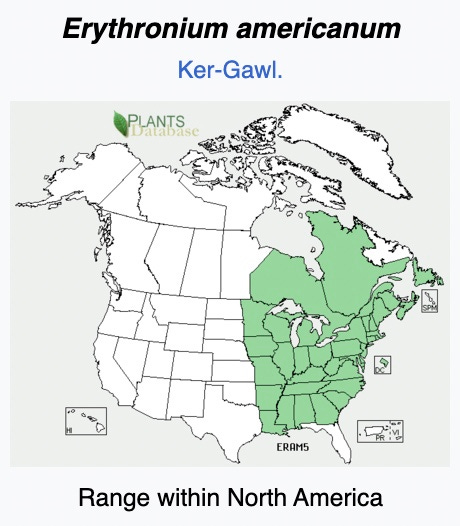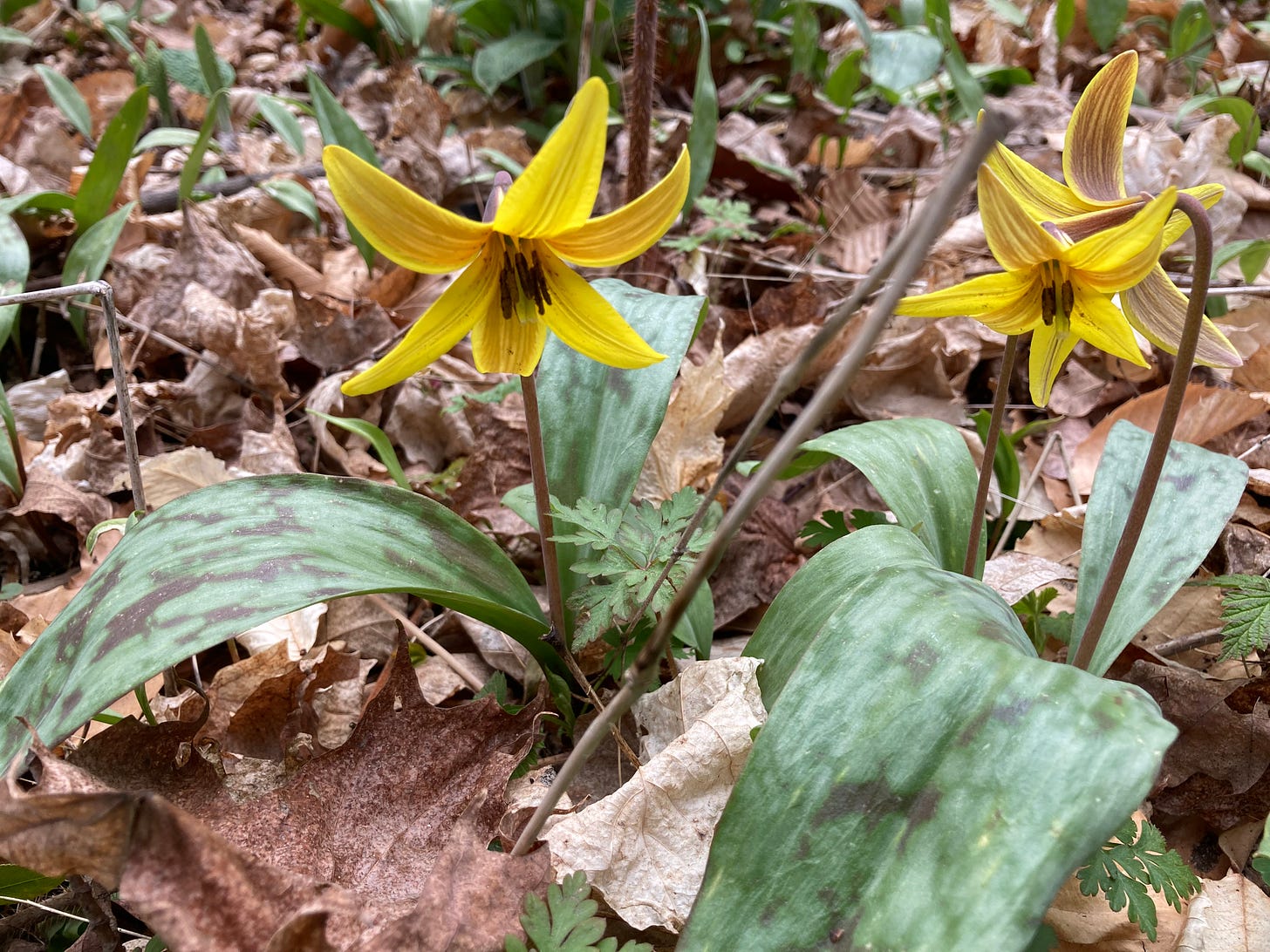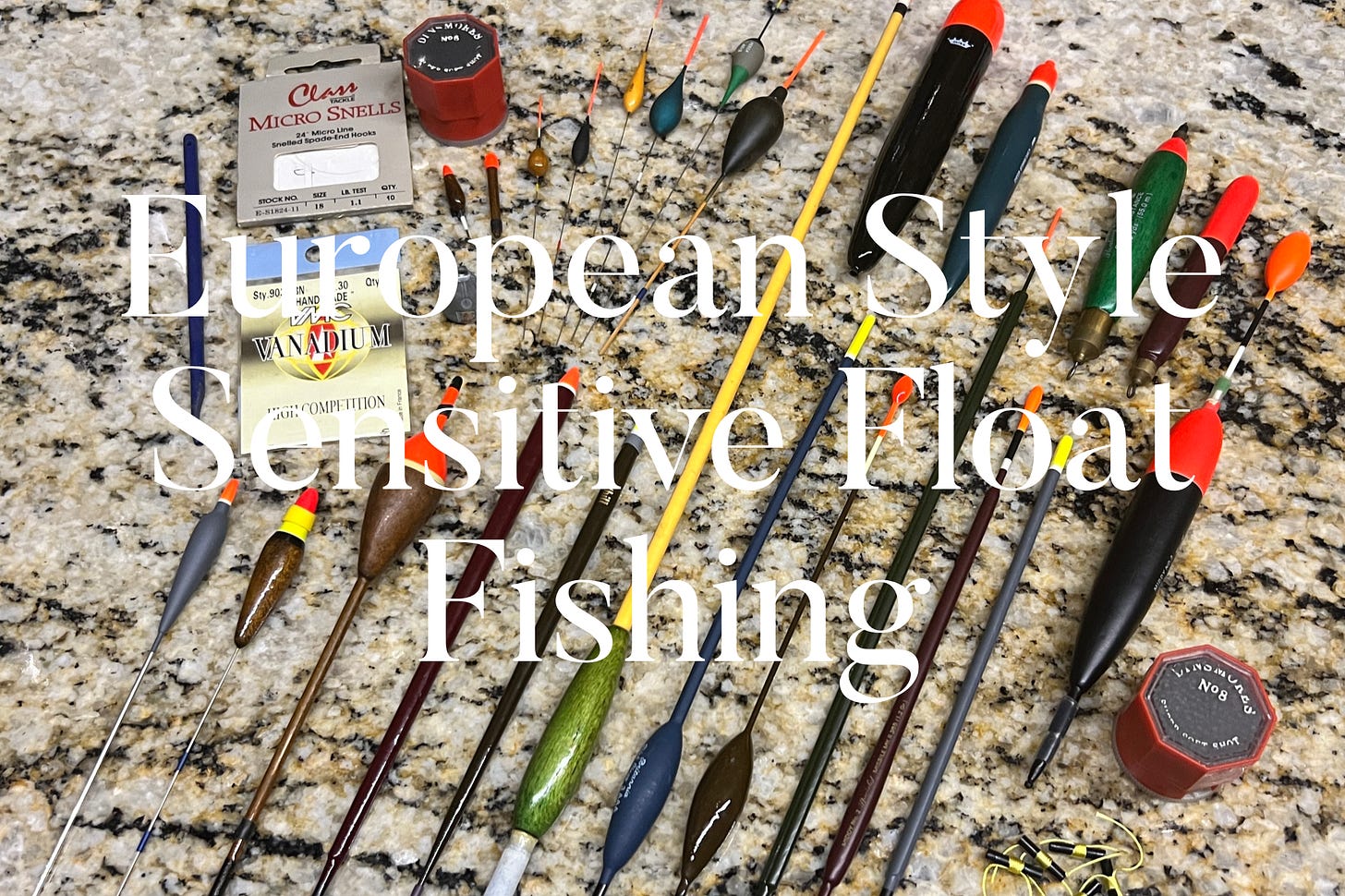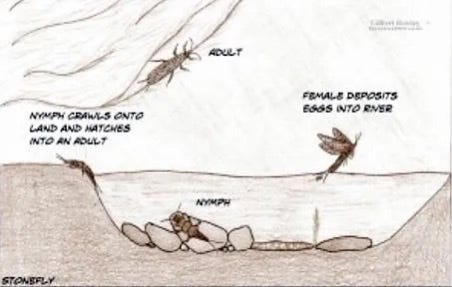December 23rd, 2023 Issue
Pest & Disease Are Not Your Enemies / Prepare For A Plethora Of Acronyms / Trout Lilies- Erythronium americanum / Float Fishing Lesson #12 Stoneflies / Fly Tying Lesson #12 Cinnamon Ant
Pest & Disease Are Not Your Enemies
One of the things you will need to understand, in order for you to be successful, is that the pests and diseases you may have been experiencing, are not your enemy. They are a revelation of a greater problem. Until you deal with the root of the problem, the pest and disease will only get worse. If you seek to deal with them, even with so called organic approved pesticides and fungicides, these “cides” (means death) will only make the problem worse, and make you even more dependent on purchased products.
So what is the root of the problem? Stress. Thats right. Stress is the real killer. It is the same way with our bodies. People under extreme levels of stress, for too long a period of time, will succumb to some kind of disease. I have watched it many times, and seen the fruit of it in my own life. Nothing will take you down faster, than too much stress. When you are stressed, worried, discouraged, you are releasing chemical in your bodies that make it much easier for parasites and diseases to get the upper hand.
So what have scientists learned about plant stress? When a plant becomes stressed, the carbon:nitrogen ratio starts to shift. A healthy plant has more carbon. A stressed plant will become more nitrogen based. This is a magnet, and candy to an insect or disease pathogen. The sugars produced in a stressed plant are more simple, and more easily digested by the pests. A healthy, vibrant plant, is producing sugars that are much more difficult for the pests to digest, so they move on to something easier to deal with. This is all part of God’s design. If your plants are put in such poor soil that it causes them to be stressed, it is best that they die, and the minerals and organic matter that make them up, begins to replenish the soil. The Lord is trying to show you your crop need to act as a cover crop. But no, most people push ahead stubbornly, and just keep taking from the soil, harvesting empty, mineral deficient food, and make everything worse for the next season. If they have been employing the “cides”, then they are also destroying whatever soil life, that might still be in existence, breaking the symbiosis that is so necessary for the plant, just exasperating the whole condition.
One of the things you need to keep in mind, is that what is stressful to one plant may not be to another. Winter Density Lettuce, is going to be very different than Sweet Potatoes. One is stressed by heat, they other thrives in it. So for you to understand how to nurture plants properly, you have to understand what stresses them. I have a form of Mexican sunflower that does not want to be watered hardly at all, it literally kills it. I also have plants like carrots that thrive on staying moist all the time. Because tomatoes come from Central American, where temperatures are much more moderated, they prefer the 70’s during the day, and 60’s at night. That is NOT a description of where I live, not even close. I have seen numerous times when it was in the 90’s one day, then a few days later we are covering things because of frost warnings. This kind of weather can play havoc on your tomatoes, because they are so fussy temperature wise, and become stressed easily. No wonder tomatoes are one of the most difficult plants to get through the season disease free.
Do you know why you won’t find hardly anyone that will teach you the kinds of approaches, that I will teach you in my newsletter? There is no money in it! I have spent over twenty years learning how to do all of this without needing to purchase products that line someone’s pocket, while they sitting behind a desk. The other reason you won’t hear it taught, is that my methods are dependent on someones willingness to give more than they take. Most people are greedy, and want to get all they can, without having to give anything. I am espousing the idea, that you need to primarily give, and while you are busy giving, you just happen to eat incredibly nutritious, mineral dense food. That happens to be pest and disease resistant.
I will never forget calling one of my favorite seed companies, and asking them, “if I used their organic approved pesticide, that was guaranteed to kill 45 insect pest, would it also kill some of my soil life?” It was very quiet on the phone for a moment, they became very uncomfortable with that question. The answer was obvious, yes if it is going to destroy life above ground, then the residues that go into the soil are going to destroy life there as well.
So what can you depend on then, to help you with pests, while you are in the process of building your soil fertility? God was gracious to give us predatory insects. I used the term, “resistant” a few paragraphs back, because I actually want all the different species of insects I can get in my garden, including ones that can be destructive. It is the same principle as needing the fox and the rabbit to be together in a healthy ecosystem. There will be an ebb and flow to their individual numbers, but they will keep each other in check.
I have specific predators that eat my Colorado potato beetle larvae. In order for them to reproduce and lay eggs for next season, I have to have some pests present. Here is a picture of my willing workers.
I just love those guys! I have dozens of them hunting my potatoes each season. I will go through my potatoes and grab some of the larvae myself, if I perceive it is more than my hunters can take care of. But I don’t hunt them very hard, turning over leaves, because I have these guys to keep fed. The sections of my garden, with the nicest soil, has the healthiest plants, that are more carbon based and see even less larvae problems. But as you are building your soil, the Lord is gracious to supply these predators that help in the mean time.
If you want to be successful, try to get as much diversity of life as you can in your garden. The more diversity you have, the more balanced everything will become. Pests and diseases were designed, to be the weaker organisms, that can only take over where there is a void, of the more powerful beneficials. If you didn’t catch that, read it again. The corporate agricultural complex wants you to be ignorant of that fact, so they can sell you something. Their products are designed to eliminate diversity, so you will have to come back each season for their help. You don’t need them!
This lesson was actually published on last Tuesday , because it was such a long message. I’m thinking, at least for a while here, that I will be posting my exhortation midweek. If you missed it, this link will take you to it.
If you know someone that you think would enjoy this newsletter, please let them know. Thank you!
Prepare For A Plethora Of Acronyms
When KNF was first translated into English, the translators gave descriptions to each different solution, and then gave them mostly three letter acronyms to present them. So like the process of one solution, is to ferment plant juice. So the name became, Fermented Plant Juice or FPJ. I’m going to list the acronyms here with their names next to them. We are going to work our way through each of these solutions (Lord Willing). Learning to make them, and then how to nurture the plants with them.
FPJ- Fermented Plant Juice
BRV- Brown Rice Vinegar
OHN- Oriental Herbal Nutrient
FAA- Fish Amino Acids
LAB- Lactic Acid Bacteria
FFJ- Fermented Fruit Juice
WCA- Water Soluble Calcium
WCAP- Water Soluble Calcium Phosphate
WK- Water Soluble Potassium
SW- Sea Water
IMO- Indigenous Microorganisms
Trout Lilies- Erythronium americanum
One of my favorite, and most prolific wild edibles, first thing in the spring, is the Trout Lily. They grow in perennial colonies, that gradually spread by the main corms, producing smaller corms. Only around 1/2% of the plants, within a colony, will flower. The plants that are going to flower, will have two large leaves, and more distinct coloration. Most corms will only produce one leaf. It takes about 4-7 years before a new colony will produce plants that are flowering. They do produce seed, and the seed is dispersed by ants. The seeds have a special fatty pouch that attracts the ants. After the fatty pouch is consumed the seeds are cast aside, thus being planted to start a new colony. As you can see from the map, this plant has adapted to an amazing range of climates. The northern edge of Hudson Bay, all the way to Louisiana.
In the spring, when the first leaves are just starting to poke through the forest leaf litter, the corms have more sugars in them, being more sweet than the corms later in the season when they are much more starchy. Most people prefer these earlier corms. But they are edible all year.
In many areas this plant is so prolific, it just carpets the forest floor for large areas. Some colonies have been found to be as old as three hundred years. Our forest has so many it would be impossible for me to put much of a dent in them. I collect the leaves and flowers for my salads many days during the three weeks or so that they are available. I have heard some people say they don’t like the flavor, others really like it. I am one that really likes them. It is just like everything else we eat. I love olives, my wife hates them.
Float Fishing Lesson #12 Stoneflies
Stoneflies are found in rivers. They are an extremely important food source, on many bodies of water. I have seen them as small as #12, but generally they are quite a bit larger. The great thing about these larger species, is that they take several years to develop. They are so calorie rich, that the fish readily and often aggressively grab them. The photo that I use for the fly tying lesson, that says Grandad’s Fly Box, is of a large black stonefly pattern of, Pteronarcys dorsata (Giant Black Stonefly). Sometimes the fish will hit these so hard, it will about pull the rod out of your hand. The great thing about the stonefly, is you can collect the nymphs, under rocks and logs, and just put them on a hook, as a live bait under a float.
The life cycle for a stonefly is pretty simple. After the adult lays its eggs, the eggs hatch and develop into nymphs that can take from a year to several years to develop. Once the nymph has reached maturity, they will climb out of the water, on a stick or exposed rock, and the nymphal shuck will split, and the adult will emerge. After the adults have mated, the female will come back to the water to lay the eggs. This can be very dramatic. I have see large fish hit them on the surface, as they are skating, laying eggs. The rise can sound like someone dropped a rock in the water. These nymphs and adults are like prime rib to these fish, and they really go for them. For some of you, these may be the most important insect for you to identify. For others you may not have them at all. But that is why I am taking time to teach you all these things, so you can find out for yourself what is important, on your favorite bodies of water. If you want to see better pictures, of any of these insects, the internet has piles of them.
Fly Tying Lesson #12 Cinnamon Ant
In this issues lesson, I show you how to tie the cinnamon ant. I hope you enjoy the lesson.
https://rumble.com/vwm1dn-fly-tying-class-lesson-12-cinnamon-ant.html
















Maybe not the same thing, but it made me think of the possible similarity. The fungal growth we want to encourage in our garden from the KNF is white fuzzy looking. Our rabbit droppings develop a white fuzzy growth on them. Is this similar? Would it still benefit my garden in the same way?